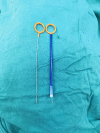A New Method of Nice Knot Elastic Fixation for Distal Tibiofibular Syndesmosis Injury
- PMID: 36710316
- PMCID: PMC9977588
- DOI: 10.1111/os.13635
A New Method of Nice Knot Elastic Fixation for Distal Tibiofibular Syndesmosis Injury
Abstract
Objective: The distal tibiofibular syndesmosis (DTS) is a fretting joint and it is still a hot issue how to satisfy strong internal fixation while allowing fretting. This study described and evaluated a new method for elastic fixation of DTS injury with Nice Knot.
Methods: The study was designed as a retrospective study. Between June 2020 and June 2021, 31 patients who were diagnosed with ankle fracture and DTS injury without additional orthopedic injuries were enrolled in this case series. The study included 22 males and nine females, with an average age of 34.71 ± 14.66 years. All patients were treated with Nice Knot binding for DTS. Surgical time, length of stay, time of DTS fixation, total weight-bearing time, complications, imaging parameters, and functional scores at follow-up were recorded. Paired sample t-tests or single factor analyses of variance were used at intra-group comparison.
Results: All patients completed surgery with normal syndesmotic parameters. The recovery of DTS injury was verified by Hook and lateral malleolus rotation tests. The average follow-up time was 15.97 ± 3.30 months. Only one case showed superficial infection after surgery, and the wound healed after symptomatic treatment. In terms of imaging, there were no significant differences in tibiofibular clear space (TFCS), tibiofibular overlap distance (TFOS), medial clear space (MCS), and superior clear space (SCS) immediately and at different follow-up points after surgery. All obtained excellent and good outcomes according to the AOFAS score at least follow-up after surgery.
Conclusions: Nice Knot elastic fixation of DTS injury is firm and stable while maintaining the physiological micromotion of the ankle joint.
Keywords: Ankle joint; Elastic fixation; Physiological micromotion; Syndesmotic parameter.
© 2023 The Authors. Orthopaedic Surgery published by Tianjin Hospital and John Wiley & Sons Australia, Ltd.
Figures




Similar articles
-
A new type of elastic fixation, using an encircling and binding technique, for tibiofibular syndesmosis stabilization: comparison to traditional cortical screw fixation.J Orthop Surg Res. 2023 Apr 3;18(1):269. doi: 10.1186/s13018-023-03579-x. J Orthop Surg Res. 2023. PMID: 37009903 Free PMC article.
-
[Clinical analysis of full-repair strategy under small incision for closed Lauge-Hansen pronation-external rotation type Ⅳ ankle fracture].Zhongguo Xiu Fu Chong Jian Wai Ke Za Zhi. 2020 Jun 15;34(6):730-736. doi: 10.7507/1002-1892.201911024. Zhongguo Xiu Fu Chong Jian Wai Ke Za Zhi. 2020. PMID: 32538564 Free PMC article. Chinese.
-
[TREATMENT OF PRONATION EXTERNAL ROTATION ANKLE FRACTURE COMBINED WITH SEPARATION OF DISTAL TIBIOFIBULAR SYNDESMOSIS].Zhongguo Xiu Fu Chong Jian Wai Ke Za Zhi. 2016 Sep 8;30(9):1081-1084. doi: 10.7507/1002-1892.20160220. Zhongguo Xiu Fu Chong Jian Wai Ke Za Zhi. 2016. PMID: 29786359 Chinese.
-
Comparison of suture button fixation and syndesmotic screw fixation in the treatment of distal tibiofibular syndesmosis injury: A systematic review and meta-analysis.Int J Surg. 2018 Dec;60:120-131. doi: 10.1016/j.ijsu.2018.11.007. Epub 2018 Nov 12. Int J Surg. 2018. PMID: 30439535
-
Ankle fractures involving the fibula proximal to the distal tibiofibular syndesmosis.Foot Ankle Int. 1997 Aug;18(8):513-21. doi: 10.1177/107110079701800811. Foot Ankle Int. 1997. PMID: 9278748 Review.
Cited by
-
Candy box technique with sutures and Nice knot : a novel approach to inferior pole patellar fractures.Bone Joint Res. 2025 Aug 22;14(8):721-734. doi: 10.1302/2046-3758.148.BJR-2024-0412.R1. Bone Joint Res. 2025. PMID: 40844083 Free PMC article.
-
Nice knots assistance in comminuted and displaced clavicle fractures reduce intraoperative blood and shorten operation time with a satisfactory postoperative clinical outcome.BMC Musculoskelet Disord. 2024 Nov 8;25(1):896. doi: 10.1186/s12891-024-08012-w. BMC Musculoskelet Disord. 2024. PMID: 39516743 Free PMC article.
-
Comparative efficacy of Nice knot versus lag screw in augmenting locking plate fixation for comminuted clavicular fractures: a retrospective cohort study.BMC Musculoskelet Disord. 2025 Jul 29;26(1):729. doi: 10.1186/s12891-025-08933-0. BMC Musculoskelet Disord. 2025. PMID: 40731346 Free PMC article.
-
Efficacy and safety of different fixation methods for acute syndesmosis injuries: protocol for a network meta-analysis of randomised and observational studies.BMJ Open. 2025 Aug 19;15(8):e092184. doi: 10.1136/bmjopen-2024-092184. BMJ Open. 2025. PMID: 40829820 Free PMC article.
-
[Application of Nice knot technique in wound closure of Gustilo type ⅢA and ⅢB open tibial fractures].Zhongguo Xiu Fu Chong Jian Wai Ke Za Zhi. 2024 Jan 15;38(1):46-50. doi: 10.7507/1002-1892.202310090. Zhongguo Xiu Fu Chong Jian Wai Ke Za Zhi. 2024. PMID: 38225840 Free PMC article. Chinese.
References
MeSH terms
LinkOut - more resources
Full Text Sources
Medical

